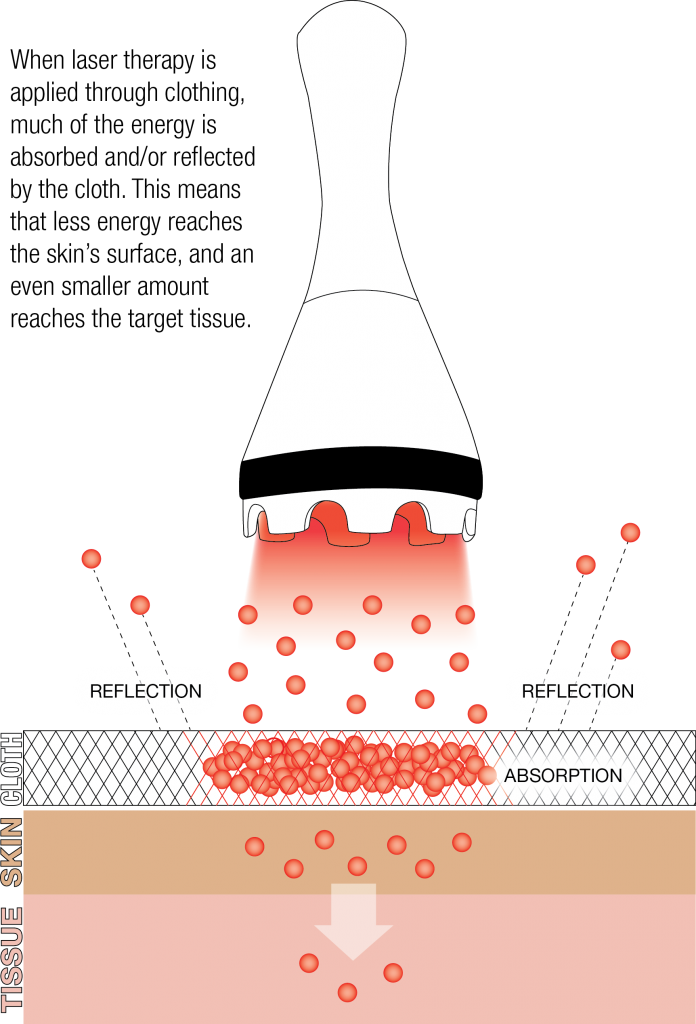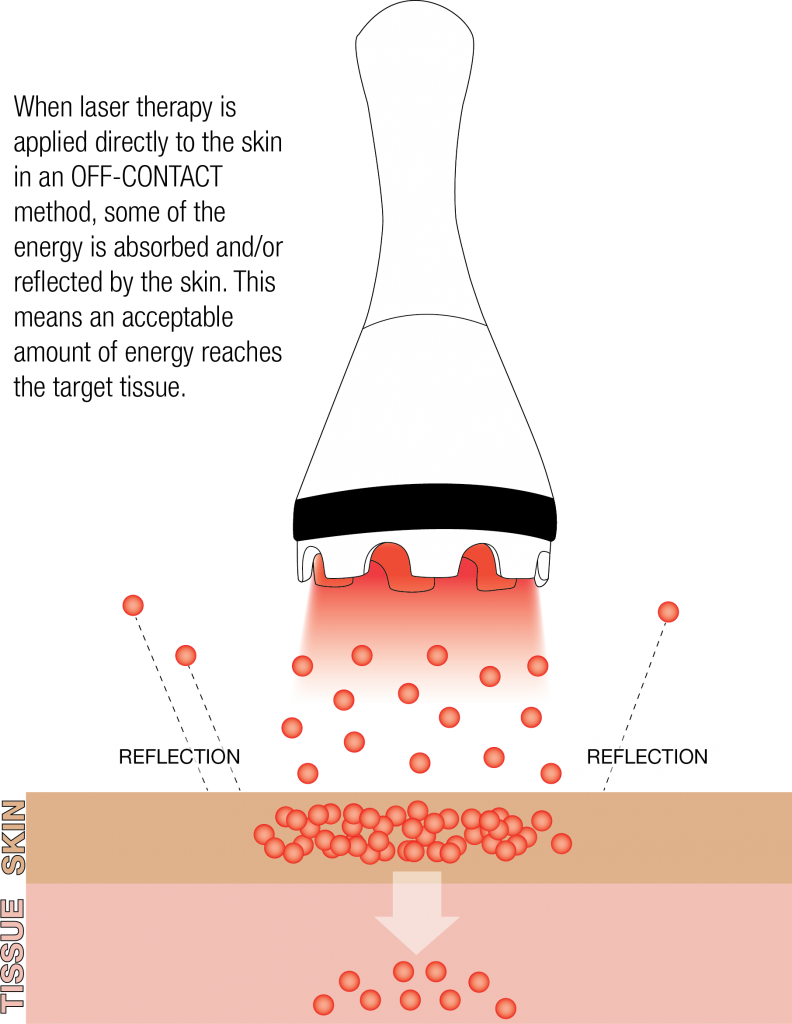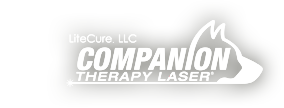Learn tips about Class IV laser therapy and other health related topics on the Companion Therapy Lasers blog! Check back weekly for updated posts.
5 Common Musculoskeletal Laser Therapy Mistakes
Guest Blog by Jeff Smith, DVM, CCRP, Middletown Animal Hospital, Middletown, CA

Not keeping the probe perpendicular: It is important to follow the contours of the body while keeping the probe perpendicular to the tissue. If you are seeing the red aiming beam coming into view as you transit the tissue with the contact head, you are likely not staying perpendicular. When the probe is not perpendicular, much more light is reflected from the tissue. This can be particularly difficult in distal extremities when treating transversely because it requires a ton of wrist movement. To avoid this, treat only 1/4-1/3 of the circumference of the limb at a time! Much easier!
Not treating the area from 360 degrees: Whenever possible treating the entire joint or target tissue from 360 degrees will achieve superior results. Sometimes we become focused on the area of visible or suspected pathology, but the truth is that all of the associated tissue is involved—think of an inflamed joint: the entire joint capsule is involved, not just the particular abnormal area identified on x-rays. Hips especially benefit from being treated from the medial aspect. Most dogs will allow this though it may take some patience and encouragement the first time or two. Backs cannot be treated from 360 degrees, but an effort should be made to administer therapy from 270 degrees.
Not treating the involved spinal nerve root segments: Most animals in chronic pain have a maladaptive or wind-up component that involves the spinal dorsal root ganglia and the associated nerves going to them. Added benefit comes from treating this separate source of pain in these patients. Moreover, the spinal column is often involved in compensatory efforts to guard the injured joint(s) from their normal range of motion, so there is a musculoskeletal benefit as well. Likewise, other joints in the affected limb will likely benefit from therapy since they have also been compensating for the abnormal weight bearing in the affected joints.
Not following an adequate induction period for chronic cases: I advise clients that induction for chronic conditions will take up to 12 treatments when administered 3X per week. I do not mention other numbers—like 6-12 treatments—because clients always remember the smaller number. If induction takes fewer treatments—fantastic! If induction takes 12 treatments, then the prescription was at least accurate. Most case should improve significantly after 3 treatments and remarkably after 6 treatments. Induction is complete once improvement has plateaued.
 Not using adjunctive modalities: Pain management, like anesthesia, is much more effective when using a multimodal approach. The new AAFP/AAHA Pain Management Guideline now state that using only pharmaceutical management of pain is no longer adequate. Similarly, using adjunctive modalities to your laser therapy—pharmaceuticals (several may be indicated), cold, PROM, massage, assistive devices, physical exercises, and underwater treadmill—will deliver superior results to your patients.
Not using adjunctive modalities: Pain management, like anesthesia, is much more effective when using a multimodal approach. The new AAFP/AAHA Pain Management Guideline now state that using only pharmaceutical management of pain is no longer adequate. Similarly, using adjunctive modalities to your laser therapy—pharmaceuticals (several may be indicated), cold, PROM, massage, assistive devices, physical exercises, and underwater treadmill—will deliver superior results to your patients.
Lasers are powerful tools that are increasingly being used for a growing number of medical applications. Lasers are used every day to remove unwanted tattoos, make incisions during surgeries, and treat aches and pains. Each of these applications works because of one of three types of laser-tissue interactions: photothermal, photomechanical, or photochemical.
Photothermal
Lasers that produce a photothermal effect use prolonged energy exposure to facilitate an increase in chromophore temperature, which in turn leads to cellular vaporization. This type of laser-tissue interaction is what occurs during surgical and hair removal laser use.
Photomechanical
Lasers relying on photomechanical effects use shorter pulses of power and thermal expansion to create acoustic waves. These waves then break up the target material into smaller particles, making it useful for applications such as tattoo removal and photo refractive keratectomy.
Photochemical
Lasers using photochemical effects do not destroy or break up tissue. Light that interacts with tissue in a photochemical manner is absorbed into the chromophores and precipitates a biological cascade of events that promotes pain relief and inflammation reduction. Photochemical laser-tissue interactions are operative in therapy applications, such as Deep Tissue Laser Therapy and photodynamic therapy.
Want to learn more about photochemical reactions? Check out this medical animation:
Have you ever looked around on a beach and seen people wearing long-sleeved shirts? While this might not be the expected wardrobe option, especially on a hot day, it’s one that makes sense for people who want to limit their sun exposure. Even a lightweight fabric is remarkably efficient at keeping the sun’s energy from reaching your skin.
Sometimes, however, you may not want that extra layer of protection from light energy. When receiving laser therapy treatments, for instance, the best outcomes are achieved when the proper amount of energy is able to reach its target within the body. If there is a layer of clothing, a dressing, a bandage or a cast between the laser and the skin, much, if not all, of the energy is lost to the material before it can enter the body.
How lasers interact with bandages
 Laser light can interact with surfaces in one of three ways: reflection, absorption, or transmission. Laser therapy works best when reflection off the skin’s surface is minimized, and absorption into the tissue maximized. By adding a layer of fabric (or cast material), the laser light is not able to interact with the body in the same way. Depending on the color of the fabric, either a greater amount of reflection off the fabric, or absorption into the fabric, will take place. This means that less of the energy is reaching the skin’s surface, and even less is reaching its target within the body.
Laser light can interact with surfaces in one of three ways: reflection, absorption, or transmission. Laser therapy works best when reflection off the skin’s surface is minimized, and absorption into the tissue maximized. By adding a layer of fabric (or cast material), the laser light is not able to interact with the body in the same way. Depending on the color of the fabric, either a greater amount of reflection off the fabric, or absorption into the fabric, will take place. This means that less of the energy is reaching the skin’s surface, and even less is reaching its target within the body.
One way to visualize this concept is to picture a tightly woven chain link fence and someone holding a bucket full of ping-pong balls. The fence represents a layer of fabric, while the balls represent the photons (or energy). If you were to throw the ping-pong balls at the fence, some would bounce off, while some would get stuck in the fence itself, leaving far fewer to make it to the other side. Laser light behaves in much the same way when it comes in contact with fabric.
Why power loss matters
Why is this concept so important? Well, this loss of energy can have dramatic effects on treatment outcomes. Laser therapy treatment protocols rely on a certain amount of energy being distributed over a given area, so when less than the recommended amount of energy is delivered, results will be variable and often disappointing.
This layer loss effect is even more pronounced with lower-power lasers. Class III lasers, for example, emit a maximum of 0.5 W, while Class IV lasers, emit much higher powers. For example, Companion Therapy Lasers can emit up to 15 Watts of power. Let us say, for demonstration purposes, that a layer of fabric  causes a 75% power loss. This means that a Class III laser emitting at 0.5 W is only delivering 125 mW to the skin’s surface when treating through clothing, while a Class IV laser emitting a 15 W would deliver 3.75 W to the skin’s surface. Based on the therapeutic relevance of these different doses, there will be a much larger disparity between the expected and actual results for the Class III laser than the Class IV. However, neither scenario is advisable. To ensure adequate dosing, laser therapy needs to be applied directly to the skin, in either a contact, or non-contact manner.
causes a 75% power loss. This means that a Class III laser emitting at 0.5 W is only delivering 125 mW to the skin’s surface when treating through clothing, while a Class IV laser emitting a 15 W would deliver 3.75 W to the skin’s surface. Based on the therapeutic relevance of these different doses, there will be a much larger disparity between the expected and actual results for the Class III laser than the Class IV. However, neither scenario is advisable. To ensure adequate dosing, laser therapy needs to be applied directly to the skin, in either a contact, or non-contact manner.
Losing layers, improving outcomes
While clothing may be beneficial on a beach, it acts as an undesirable barrier during a laser therapy treatment session, preventing much of the laser energy from reaching its target. By stripping off the common misconception that it is acceptable to treat through clothing, casts, dressings or any material, you will greatly improve outcomes by delivering more consistent and effective treatments.
Watch the short video demonstration below to see how much energy is lost in different type of fabric. See for yourself why treating through clothing, casts, and bandages is not effective. Watch the numbers on the power meter go down as the laser emits through different types of fabric.



